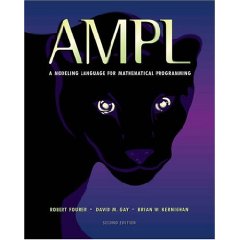
Mathematical optimization or mathematical programming is the selection of a best element, with regard to some criterion, from some set of available alternatives. It is generally divided into two subfields: discrete optimization and continuous optimization. Optimization problems arise in all quantitative disciplines from computer science and engineering to operations research and economics, and the development of solution methods has been of interest in mathematics for centuries.

AMPL is an algebraic modeling language to describe and solve high-complexity problems for large-scale mathematical computing . It was developed by Robert Fourer, David Gay, and Brian Kernighan at Bell Laboratories. AMPL supports dozens of solvers, both open source and commercial software, including CBC, CPLEX, FortMP, MOSEK, MINOS, IPOPT, SNOPT, KNITRO, and LGO. Problems are passed to solvers as nl files. AMPL is used by more than 100 corporate clients, and by government agencies and academic institutions.
The general algebraic modeling system (GAMS) is a high-level modeling system for mathematical optimization. GAMS is designed for modeling and solving linear, nonlinear, and mixed-integer optimization problems. The system is tailored for complex, large-scale modeling applications and allows the user to build large maintainable models that can be adapted to new situations. The system is available for use on various computer platforms. Models are portable from one platform to another.
MPS is a file format for presenting and archiving linear programming (LP) and mixed integer programming problems.
IPOPT, short for "Interior Point OPTimizer, pronounced I-P-Opt", is a software library for large scale nonlinear optimization of continuous systems. It is written in Fortran and C and is released under the EPL. IPOPT implements a primal-dual interior point method, and uses line searches based on Filter methods. IPOPT can be called from various modeling environments and C.

Computational Infrastructure for Operations Research (COIN-OR), is a project that aims to "create for mathematical software what the open literature is for mathematical theory." The open literature provides the operations research (OR) community with a peer-review process and an archive. Papers in operations research journals on mathematical theory often contain supporting numerical results from computational studies. The software implementations, models, and data used to produce the numerical results are typically not published. The status quo impeded researchers needing to reproduce computational results, make fair comparisons, and extend the state of the art.
The TOMLAB Optimization Environment is a modeling platform for solving applied optimization problems in MATLAB.
Algebraic modeling languages (AML) are high-level computer programming languages for describing and solving high complexity problems for large scale mathematical computation. One particular advantage of some algebraic modeling languages like AIMMS, AMPL, GAMS, Gekko, MathProg, Mosel, and OPL is the similarity of their syntax to the mathematical notation of optimization problems. This allows for a very concise and readable definition of problems in the domain of optimization, which is supported by certain language elements like sets, indices, algebraic expressions, powerful sparse index and data handling variables, constraints with arbitrary names. The algebraic formulation of a model does not contain any hints how to process it.
Bilevel optimization is a special kind of optimization where one problem is embedded (nested) within another. The outer optimization task is commonly referred to as the upper-level optimization task, and the inner optimization task is commonly referred to as the lower-level optimization task. These problems involve two kinds of variables, referred to as the upper-level variables and the lower-level variables.
A complementarity problem is a type of mathematical optimization problem. It is the problem of optimizing (minimizing or maximizing) a function of two vector variables subject to certain requirements (constraints) which include: that the inner product of the two vectors must equal zero, i.e. they are orthogonal. In particular for finite-dimensional real vector spaces this means that, if one has vectors X and Y with all nonnegative components (xi ≥ 0 and yi ≥ 0 for all : in the first quadrant if 2-dimensional, in the first octant if 3-dimensional), then for each pair of components xi and yi one of the pair must be zero, hence the name complementarity. e.g. X = (1, 0) and Y = (0, 2) are complementary, but X = (1, 1) and Y = (2, 0) are not. A complementarity problem is a special case of a variational inequality.
Mathematical programming with equilibrium constraints (MPEC) is the study of constrained optimization problems where the constraints include variational inequalities or complementarities. MPEC is related to the Stackelberg game.
In mathematical optimization, Lemke's algorithm is a procedure for solving linear complementarity problems, and more generally mixed linear complementarity problems. It is named after Carlton E. Lemke.
nl is a file format for presenting and archiving mathematical programming problems. Initially, this format has been invented for connecting solvers to AMPL. It has also been adopted by other systems such as COIN-OR, FortSP, and Coopr.
AIMMS is a prescriptive analytics software company with offices in the Netherlands, United States and Singapore.

SICONOS is an Open Source scientific software primarily targeted at modeling and simulating non-smooth dynamical systems (NSDS):
SAMPL, which stands for "Stochastic AMPL", is an algebraic modeling language resulting by expanding the well-known language AMPL with extended syntax and keywords. It is designed specifically for representing stochastic programming problems and, through recent extensions, problems with chance constraints, integrated chance constraints and robust optimization problems. It can generate the deterministic equivalent version of the instances, using all the solvers AMPL connects to, or generate an SMPS representation and use specialized decomposition based solvers, like FortSP.
MINOS is a Fortran software package for solving linear and nonlinear mathematical optimization problems. MINOS may be used for linear programming, quadratic programming, and more general objective functions and constraints, and for finding a feasible point for a set of linear or nonlinear equalities and inequalities.
Artelys Knitro is a commercial software package for solving large scale nonlinear mathematical optimization problems.


